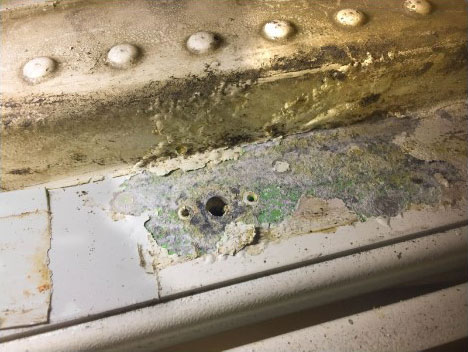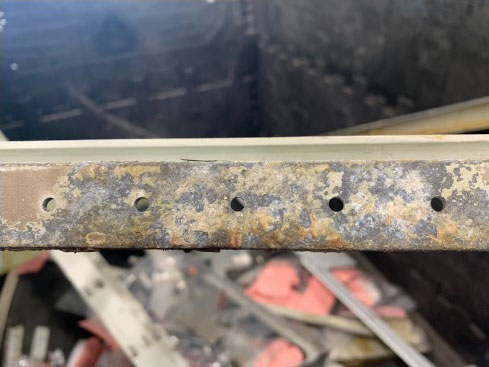There are many different corrosion removal techniques available to help eliminate corrosive damage when it happens. Each method is tailored to a certain classification and extent of the damage. Once you determine the damage type, you can choose the proper removal technique, abrasive method, and treatment tools to fit your specifications. Prior to beginning with any corrosion removal technique, make sure you have the appropriate safety equipment with any necessary eye, skin, or respiratory protection.
The aim of this article is to help you determine the best corrosion removal technique given your aircraft's needs. With this understanding, you will be able to mitigate costs and extend your equipment's lifespan.

The first step in determining the appropriate removal technique is categorizing the level of damage. This is done by first cleaning the area thoroughly and then inspecting it. The categorization criteria are as follows:
The aircraft maintenance manuals should provide corrosion tolerances. Corrosion less than the "light" level may be considered to be allowable damage that does not need to be immediately remedied. Instead, special attention may be required during an inspection and proper anti-corrosive measures should be applied. If damage to removable equipment falls into one of the above categories, the component must be removed from the surrounding structure in order to be fully inspected and repaired. Next, the primer, paint, and sealant must be removed through either mechanical or chemical means. It is imperative that these steps be executed properly for the repair to be successful.
Additionally, the corrosion depth measurement must be accurately recorded. This is often feasible with a simple magnifying glass and straight edge. Other methods such using as a dial depth gage or impression material are also acceptable and more accurate means of depth measurement.

Following the evaluation, the removal technique is selected according to the extent of the damage. As described above, a mechanical removal method utilizing an abrasive tool is usually selected because it is the most effective and efficient solution. Abrasive methods can be either hand operated or powered.
Whenever a tool (hand-operated or mechanized) is used to remove corrosion, it should ideally be of the same material as the base material or an inert material like plastic. This is to prevent the addition of particles that may cause increased corrosion. An example of this would be using steel abrasive wool to remove corrosion from aluminum. Steel particles will become embedded in the aluminum and may cause galvanic corrosion.
The techniques listed below are most applicable to less extensive damage such as cases of light corrosion. Oftentimes, these small problems can be quickly rectified with abrasive paper or abrasive wool. These remedies are also particularly useful for oddly shaped parts, tubing, or other equipment that sticks out from a more uniform surface.
Powered tools are used to address more extreme corrosion or damage over larger areas. The main advantage of these mechanized methods is the speed with which they can cover large surface areas. However, improper usage can also cause more damage due to the stress and pressure of the grinding. The metal must be periodically allowed to cool to prevent overheating. The risks of power sanding are mitigated through proper training and safety education.
In the case of corroded steel; deep pitting, nicks, and gouges can be removed through a burnishing process. This is performed with a special tool that flattens the metal surface with heat and pressure. It must only be performed on acceptable parts and not done around fasteners, joints, or edges which could be damaged by the burnishing process.
When it comes to aluminum, corrosion must be removed from pits. In the case of pitting on a critical structure, the pit hole must be blended so that there are no sharp corners. The final blended area must be saucer-shaped with the major axis oriented to limit its effect on structural integrity. On non-critical structures, the edges do not need to be blended.
Additionally, chemical removal techniques can also be used that function similarly but are less common because they pose increased health and safety risks. The most common of these is the application of an acid soak which is only removed after it has burned through the corroded layer.
It is important to note that the above-mentioned techniques are the most commonly used corrosion removal techniques. For aircraft, however, it is required that the specific methods for that aircraft must be followed as per the manufacturer or regulatory guidelines.
After these corrosion removal techniques have been implemented, the surface typically needs to be cleaned and finished to complete the repair process. Most commonly, this is done by abrasive blasting, a process that removes debris using a high-pressure stream of rough particles. Following this, the proper are then applied.
Despite your best efforts to protect against corrosion, some will always occur over time due to exposure to environmental risk factors as well as through the natural aging process of the aircraft. Foreknowledge of the various types of corrosion will enable you to apply the optimal corrosion removal techniques in order to economically and efficiently tackle the issue. To learn more about corrosive processes and the ways to combat them, contact an Av-DEC representative today.